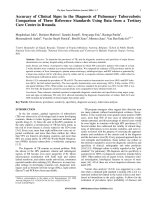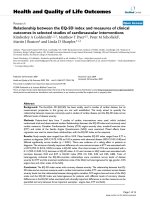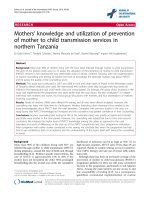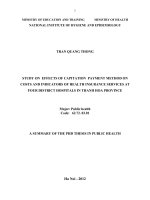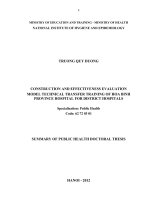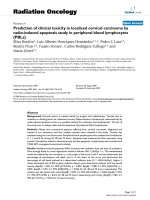Costing of clinical services in rural district hospitals in northern vietnam
Bạn đang xem bản rút gọn của tài liệu. Xem và tải ngay bản đầy đủ của tài liệu tại đây (88.35 KB, 11 trang )
international journal of health planning and management
Int J Health Plann Mgmt 2010; 25: 63–73.
Published online 22 January 2009 in Wiley InterScience
(www.interscience.wiley.com) DOI: 10.1002/hpm.970
Costing of clinical services in rural district
hospitals in northern Vietnam
Hoang Van Minh1 *, Kim Bao Giang2 , Dao Lan Huong3,
Le Thi Huong4 , Nguyen Thuy Huong5 , Pham Ngan Giang6,
Luu Ngoc Hoat7 and Pamela Wright8
1
Department of Health Economics, Hanoi Medical University, Hanoi, Vietnam
Department of Health Management, Hanoi Medical University, Hanoi, Vietnam
3
Institute of Health Strategy and Policy, Ministry of Health, Hanoi, Vietnam
4
Centre of Excellence in Research, Hanoi Medical University, Hanoi, Vietnam
5
The Netherlands–Vietnam Medial Committee, Hanoi, Vietnam
6
Department of Science, Ministry of Health, Hanoi, Vietnam
7
Department of Biostatistics, Hanoi Medical University, Hanoi, Vietnam
8
Medical Committee Netherlands–Vietnam, Hanoi, Vietnam
2
SUMMARY
Objectives: This study aimed to estimate and analyse the ‘‘actual’’ unit cost of providing key
clinical services in selected rural district hospitals in the North of Vietnam. It also examined
the relationship between actual costs and the levels of cost covered by the corresponding user
fees paid by patients.
Methods: This was a facility-based costing study which estimates the costs of health care
services from the perspective of the service providers. Three rural district hospitals from three
provinces in the North of Vietnam were purposively selected for this study. The ‘‘step-down’’
approach was applied.
Results: There was little difference in the costs of an outpatient visit across the hospitals, but
the costs of an operation and an inpatient day varied considerably. In terms of cost structure,
personnel costs accounted for the highest share of total cost of the clinical services. The shares
of operating cost were considerable while depreciation of buildings/equipments made up a
small ‘‘proportion’’. The study results revealed that the user fee levels were much lower than
the actual costs of providing the corresponding services. The present study highlights the
importance of costing data for hospital planning and management. Copyright # 2009 John
Wiley & Sons, Ltd.
key words: costing; district hospitals; planning and management; Vietnam
INTRODUCTION
Hospitals play a key role in the health care system as referral institutions for higher
level curative care, as training facilities for health care workers and as organizational
* Correspondence to: H. V. Minh, Department of Health Economics, Hanoi Medical University, No. 1, Ton
That Tung, Dong Da, Hanoi, Vietnam. E-mail:
Copyright # 2009 John Wiley & Sons, Ltd.
64
H. V. MINH ET AL.
platforms for primary care activities, including preventive services. However, this
positive effect of hospitals is paid for by high costs: hospitals are the largest and most
costly health care institutions and require more human and financial resources than
any other institution or programme in this sector (Newbrander et al., 1992).
Hospital costs are determined by many factors, including the input resources used
to run hospitals, the quantity and qualifications of hospital staff and the infrastructure
and equipment. Hospital costs are strongly related to the hospital’s scale and scope.
The question about scale is whether larger hospitals are more or less efficient than
smaller ones. On the one hand, hospitals require large investments in capital such as
buildings, equipment and specialized staff, which may make it more efficient to have
one large hospital rather than two small ones. On the other hand, hospitals are
complex organizations to manage, and a smaller hospital may run more smoothly
than a larger one. The question about scope is whether or not it is efficient to combine
outpatient and inpatient care at the same facility. In some cases, it may be more efficient for physicians to provide both types of care from a single office at the hospital.
In other cases, it may be more efficient to reduce the daily flow of a large volume of
outpatients at the hospital by having separate facilities (Weaver and Deolalikar,
2004). Factors such as ALOS, bed occupancy and patient throughput contribute
significantly to the differences in unit costs.
During the period of the centrally planned economy (the eighties), all health
services in Vietnam were provided free of charge to the whole population. During the
process of development according to a market economy, financial resources for
health care in hospitals were increased when, in 1989, hospitals in Vietnam started
collecting fees for the services provided to patients, following the Government’s
Decision 45 (The Government of Vietnam, 1989). However, hospital fees presently
only levy charges for services such as hospital bed use, nursing, drugs, blood, tests
and X-ray films. A large part of the costs is still subsidized by the Government.
During the decentralization process, the Government of Vietnam passed Decree
10 (The Government of Vietnam, 2002) in 2002 and Decree 43 (The Government of
Vietnam, 2006) in 2006, which put in place a financial regime to be applied in all
government revenue-raising agencies, including hospitals. According to these
policies, the Government would allocate a pre-determined amount from the state
budget to hospitals. The hospital managers would be in charge of using this source of
funds to ensure the continuity of technical activities. As a result, hospital managers in
Vietnam nowadays have both more power and more responsibility in using the state
budget as well as in mobilizing additional resources from the society. They face
significant pressure to contain the rate of cost increase, while at the same time
ensuring the quality of health care services. Hospital managers may also need to top
up revenues from user fees to cover the cost of services.
In order for hospitals in Vietnam provide the population with effective and efficient, high-quality health care services, hospital managers urgently need information
on the actual costs of the services they provide. Cost information on different aspects
is extremely useful to health planners and decision makers, especially hospital
managers, to make more evidence-based decisions in planning and management. The
knowledge of actual costs incurred in producing health services is also essential in
assessing the effectiveness and efficiency of their institution.
Copyright # 2009 John Wiley & Sons, Ltd.
Int J Health Plann Mgmt 2010; 25: 63–73.
DOI: 10.1002/hpm
COSTING OF CLINICAL SERVICES IN NORTHERN VIETNAM
65
In Vietnam, district hospitals have a crucial role in the primary health care
network, both supporting the commune health centres and acting as a gateway to
more specialist care. Although good financial management of district hospitals has
high priority for the Government, data on ‘‘real’’ costs of providing health services at
this type of health facility have been very scarce.
This study, therefore aimed to estimate and analyse the unit costs of providing key
clinical services in selected rural district hospitals in the North of Vietnam. It also
aimed to establish the relationship between the real cost of providing services and the
user fees paid by patients for the corresponding services. The findings from this
costing exercise can provide basic financial management evidence for the routine
work of hospital managers. The ultimate goal of this work is to contribute to
improved financial planning and management in district hospitals in Vietnam.
METHODS
Study design
This was a facility-based costing study which estimated the costs of health care
services from the perspective of the service providers.Study setting and sample size
Three rural district hospitals in three provinces in the North of Vietnam were
purposively selected for this study. The hospitals were: (1) Dan Phuong District
Hospital in Ha Tay province, located 35 km east of the capital city of Hanoi; (2) Yen
Dung District Hospital in Bac Giang province, 60 km north of Hanoi and (3) Dai Tu
District Hospital in Thai Nguyen province, 85 km north of Hanoi. These hospitals
were selected because: (1) they were considered typical for rural district hospitals in
the North of Vietnam in terms of size, staffing and infrastructure; (2) they provided
most of the services included in the district hospital package and (3) they had a
reasonably good accounting system.
Selection of clinical services
In this study, the costs of providing key clinical services of district hospitals in
Vietnam were estimated, namely (1) cost per out-patient visit; (2) cost per inpatient
bed-day in four key departments of a district hospital, namely Surgery, Internal
Medicine, Obstetrics and Gynecology and Pediatrics and (3) cost per operation level
A. (The official statistics of the Ministry of Health distinguish between operations of
complexity A, B and C). In this costing exercise, as suggested by a previous study in
Vietnam, operations level A were weighted by a factor of 1, level B by 0.75 and level
C by 0.5 (Lieu et al., 2005).
Costing approach
In this study, the ‘‘step-down’’ approach was applied. This is the process of
allocating, step-by-step, the administration costs to supporting cost centres then to
service-delivery cost centres. The purpose of the method is to allocate all costs to
Copyright # 2009 John Wiley & Sons, Ltd.
Int J Health Plann Mgmt 2010; 25: 63–73.
DOI: 10.1002/hpm
66
H. V. MINH ET AL.
departments delivering services (Drummond et al., 2005). The allocation key was
floor space (e.g. cleaning materials), direct costs of final cost centres (e.g. general
administration), costs of staff (e.g. personnel administration) and number of beddays (e.g. laundry). The method was previously applied and described in detail in a
previous cost study in Vietnam (Vander Plaetse et al., 2005).
Firstly, the costs of each department were collected. Secondly, the costs were
allocated step-by-step to the departments. The costs of the first service cost centre
were allocated to the other cost centre and then to the final cost centre. The hospital
departments were identified based on the organizational structure of each hospital,
then separated into direct and indirect cost centres. Direct cost centres render
services directly to patients (all clinical departments, X-ray and laboratories),
indirect cost centres support other indirect cost centres or final cost centres (e.g.
kitchen, administration). Afterwards, the accumulated costs of the next service cost
centre were apportioned in the same way. This procedure was repeated step-by-step
until all service cost centres were allocated to the final cost centres. Lastly, unit costs
were calculated by dividing the total cost of each final cost centre (service
department) by an appropriate measure of its output (e.g. number of outpatient visits,
number of inpatient days).
Cost components
All the inputs (cost components) used in each cost centre were listed, quantified and
valued. Both direct and indirect costs of producing services were captured. The cost
components that were included in the costing are described in Table 1. Personnel
costs included salaries, allowances, insurance fees, professional hazard/risk
payments and incentive bonuses. For each clinical department, the labour cost
was calculated by taking the total annual payroll for each clinical department,
converting it to a daily amount and dividing it by the total number of beds in the
department. Then for each patient, the total length of stay in days was multiplied by
the labour cost per day for the department where they were treated to get the total
clinical labour cost. Capital costs included straight-line depreciations of buildings,
vehicles, equipment and other assets. The original total purchase price of fixed assets
was obtained from the Finance and Accounting Department at each hospital. The
Fixed Assets Report separately lists each fixed asset at the hospital, and is updated
annually with new capital expenditures and renovations. Fixed assets were listed by
Table 1. Cost components included in the costing exercise
Type of cost
Administration
Supporting
cost centres
Direct
Indirect
Service-delivery
cost centres
Personnel costs
Buildings, equipment
Operating costs
Personnel costs
Buildings, equipment
Operating costs
Copyright # 2009 John Wiley & Sons, Ltd.
Personnel costs
Buildings, equipment
Operating costs
Int J Health Plann Mgmt 2010; 25: 63–73.
DOI: 10.1002/hpm
COSTING OF CLINICAL SERVICES IN NORTHERN VIETNAM
67
the department. The value of the buildings at the time of their construction was
collected and the value of any major renovations was added. The depreciation costs
were calculated separately for each clinical and para-clinical department and for the
general assets of the hospital. Operating costs included electricity, water, fuel, office
supplies, telecommunications, transport of materials, maintenance and repair of fixed
assets, travel, meetings and conferences, study tours, training and scientific research,
etc. Due to the lack of available data, we were not able to capture certain costs such as
the cost of land for building or the cost of long-term staff training.
Data collection
Data were collected by four researchers together with two staff members in each
selected hospital (a person with access to data, information on finance, equipment,
staff and hospital activities and with capacity to make calculations and use a
computer). The main sources of data were activity and accounting reports of the
hospitals under study.
Data processing and analysis
The data were processed and analysed using Excel spreadsheets. In calculating
straight-line depreciations, the useful life of buildings and equipment was assumed to
be 33 and 10 years, respectively (Ministry of Finance of Vietnam, 2000). Local
currency values were converted into US dollars using the 2006 exchange rate of US$
1 ¼ VND 16 000.
RESULTS
Table 2 shows the basic characteristics and activity statistics for the three hospitals in
2006. The hospitals were quite similar in terms of number of departments, staff and
planned beds. The bed occupancy rates were very high in all the hospitals, especially
Dai Tu District Hospital (109%) and Yen Dung District Hospital (125%). However,
there was variation in the outputs produced by the three hospitals. The numbers of
outpatient visits in two hospitals were similar at around 70 000 per year but one had
nearly double that, at more than 130 000. The numbers of inpatient days were more
Table 2. Basic characteristics and activity statistics of district hospitals, 2006
Characteristics/statistics
Dan Phuong
Number of departments
Number of staff
Number of planned beds
Bed-occupancy rate
Number of out-patient visits
Number of inpatient days
Number of operation
Copyright # 2009 John Wiley & Sons, Ltd.
17
98
118
96%
71 451
41 189
541
Yen Dung
14
85
120
125%
131 249
54 865
302
Dai Tu
13
84
112
109%
75 543
44 386
383
Int J Health Plann Mgmt 2010; 25: 63–73.
DOI: 10.1002/hpm
68
H. V. MINH ET AL.
Table 3. Unit costs of selected clinical services provided in district hospitals, 2006 (in US$)
Services
Dan Phuong
Yen Dung
Dai Tu
0.40
40.43
7.66
2.71
5.40
1.84
4.40
0.65
68.67
3.69
3.23
3.63
3.57
3.53
0.52
53.29
5.05
4.44
2.21
3.12
3.70
Out-patient visit
Operation
Inpatient day in surgery
Inpatient day in obstetrics and gynaecology
Inpatient day in internal medicine
Inpatient day in paediatrics
Average cost of an inpatient day
comparable, ranging from 41 189 to 54 865. The numbers of operations also varied
from 302 to 541.
The costs of providing the selected clinical services in the studied hospitals are
presented in Table 3. In general the hospital in Yen Dung had costs about 50% higher
than the other two, with the notable exceptions of a day as inpatient in the Surgery or
Internal Medicine departments, where Yen Dung had the lowest cost. Differences
between the costs of an outpatient visit across the hospitals were relatively small. The
cost of an operation also varied among the hospitals and was much higher in Yen
Dung than in Dan Phuong.
In all three hospitals, the second most expensive service was an inpatient day in the
Surgery Department, although this cost also differed among the hospitals.
Comparing the cost of an inpatient day among departments within one hospital,
we found that for Dan Phuong District Hospital, the least expensive inpatient day was
in the Paediatrics Department (US$ 1.84). In Yen Dung, the cost as lowest in
Obstetrics and Gynaecology at US$ 3.23, while in Dai Tu Hospital, the Internal
Medicine Department charged only US$ 2.21 for an inpatient day.
The cost structures of the selected services are illustrated in Tables 4–6. The
findings demonstrate that personnel costs accounted for the highest share of total cost
of services in all three hospitals. Depreciation of buildings/equipments made up only
a small proportion of total costs. The tables also show that the share of operating
costs (cost of electricity, water, fuels and office consumables, etc) was considerable,
especially in Dan Phuong and Dai Tu District Hospitals.
Table 4. Cost structures of selected services in Dan Phuong District Hospital, 2006
Personnel
Outpatient visit
Operation
Inpatient day in surgery
Inpatient day in obstetrics
and gynaecology
Inpatient day in internal
medicine
Inpatient day in paediatrics
Ã
0.18
22.35
3.16
1.32
(45%)
(55%)
(41%)
(49%)
Building,
equipment
0.03
1.96
0.12
0.21
(8%)
(5%)
(2%)
(8%)
Operating
cost
0.12
10.33
2.8
0.56
(30%)
(26%)
(37%)
(21%)
IndirectÃ
0.07
5.79
1.57
0.62
(17%)
(14%)
(21%)
(23%)
Total
0.4
40.43
7.66
2.71
(100%)
(100%)
(100%)
(100%)
2.61 (48%)
0.06 (1%)
1.75 (32%)
0.98 (18%)
5.4 (100%)
0.9 (49%)
0.04 (2%)
0.57 (31%)
0.32 (17%)
1.84 (100%)
Indirect costs were allocated from administration and supporting departments.
Copyright # 2009 John Wiley & Sons, Ltd.
Int J Health Plann Mgmt 2010; 25: 63–73.
DOI: 10.1002/hpm
69
COSTING OF CLINICAL SERVICES IN NORTHERN VIETNAM
Table 5. Cost structures of selected services in Yen Dung District Hospital, 2006
Personnel
Outpatient visit
Operation
Inpatient day in surgery
Inpatient day in obstetrics
and gynaecology
Inpatient day in internal
medicine
Inpatient day in paediatrics
0.37
43.33
1.98
1.76
(56%)
(63%)
(54%)
(55%)
Building,
equipment
0.02
5.63
0.3
0.23
(4%)
(8%)
(8%)
(7%)
Operating
cost
0.08
11.26
0.7
0.61
(13%)
(16%)
(19%)
(19%)
IndirectÃ
0.18
8.46
0.71
0.63
(27%)
(12%)
(19%)
(19%)
Total
0.65
68.67
3.69
3.23
(100%)
(100%)
(100%)
(100%)
2.04 (56%)
0.07 (2%)
0.49 (13%)
1.03 (28%)
3.63 (100%)
1.92 (54%)
0.07 (2%)
0.5 (14%)
1.09 (30%)
3.57 (100%)
Ã
Indirect costs were allocated from administration and supporting departments.
Table 6. Cost structures of selected services in Dai Tu District Hospital, 2006
Outpatient visit
Operation
Inpatient day in surgery
Inpatient day in obstetrics
and gynaecology
Inpatient day in internal
medicine
Inpatient day in paediatrics
Personnel
Building
equipment
Operating
cost
IndirectÃ
Total
0.21
23.46
2.27
1.85
0.03
4.95
0.32
0.07
0.16
11.78
1.18
1.41
0.13
13.11
1.28
1.1
0.52
53.29
5.05
4.44
(40%)
(44%)
(45%)
(42%)
(5%)
(9%)
(6%)
(2%)
(31%)
(22%)
(23%)
(32%)
(24%)
(25%)
(25%)
(25%)
0.82 (37%)
0.05 (2%)
0.75 (34%)
0.59 (27%)
1.36 (44%)
0.06 (2%)
0.95 (31%)
0.74 (24%)
(100%)
(100%)
(100%)
(100%)
2.21 (100%)
3.12 (100%)
Ã
Indirect costs were allocated from administration and supporting departments.
In Figure 1, a comparison is shown between maximum hospital fee levels,
according to official user fee policy (The Government of Vietnam, 1989), and the
corresponding actual costs in the three hospitals. The fee levels were found to be
much lower than the actual costs of providing those services. The cost recovery
percentages were especially low for surgical operations, ranging from 7 (in Yen
Dung District Hospital) to 12% (in Dan Phuong District Hospital) of the actual cost
to the hospital.
DISCUSSION
Due to a weak information system and a lack of resources devoted to hospital
management, cost data are seldom available from routine information systems in
Vietnam (Lieu et al., 2005). That means that research studies providing at least
estimates of the costs of providing health care are needed as basic information for
hospital planning and management in Vietnam.
We focused on cost estimates for clinical services because these are usually the
largest components of total hospital costs (Oostenbrink et al., 2003). We attempted to
Copyright # 2009 John Wiley & Sons, Ltd.
Int J Health Plann Mgmt 2010; 25: 63–73.
DOI: 10.1002/hpm
70
H. V. MINH ET AL.
Figure 1. Comparisons between maximum hospital fee levels applied in district hospitals
(according to user fee policy in Vietnam) and the corresponding actual costs in each hospital in
2006
make a preliminary assessment of the efficiency of the hospitals’ performance by
estimating and comparing the cost levels and structures of the key services provided
in three district hospitals which were quite similar in terms of infrastructure. We also
estimated how much of the cost of selected key services provided by the district
hospitals was covered by user fees.
The cost levels found in this study demonstrate both similarities and differences to
what has been reported by the few previous cost studies in Vietnam. In 2000, the cost
of an outpatient visit to a district hospital in the North of Vietnam was reported to
vary between US$ 0.27 and US$ 0.65, the cost of an inpatient day ranged from US$
0.81 to US$ 2.62 and the cost of an operation was between US$ 77.83 and US$
279.82 (Steffen Flessa, 2004). A more recent study by Mediconsult Vietnam found
that the costs of an outpatient visit in a district hospital in 2007 varied between US$
0.21 and US$ 0.43, the cost of an inpatient day ranged from US$ 2.31 to US$ 6.45
and the cost of an operation was between US$ 28.51 and US$ 47.61 (Mediconsult
Vietnam, 2007) (Table 7).
In fact, hospital costs are determined by many factors such as resources available
to hospitals, experience, mix and specialization of medical staff, equipment,
Table 7. Comparison of cost figures from this study and previous studies
Services
This study
Outpatient visit
Inpatient day
Operation
0.40–0.65
1.84–7.66
40.43–68.67
Steffen Flessa, 2004
Mediconsult Vietnam, 2007
0.27–0.65
0.81–2.62
77.83–279.82
0.21–0.43
2.31–6.45
28.51–47.61
Copyright # 2009 John Wiley & Sons, Ltd.
Int J Health Plann Mgmt 2010; 25: 63–73.
DOI: 10.1002/hpm
COSTING OF CLINICAL SERVICES IN NORTHERN VIETNAM
71
technology and economies of scale. For hospitals at different levels and even within
the same level, different ways of allocating resources within the hospital and
differences in case mix also result in differences in cost results, as do utilization rates.
A previous study found that economies of scale of hospitals in Vietnam depended on
the category of the hospital in addition to the number of beds and volume of output.
(Hanson and Gilson, 1996)
There are also many factors, beside efficiency issues, that can influence the cost
estimates such as the patient case mix, the scope of the study, definition of costs,
methods for costing, cost components included in the costing, availability and quality
of data, the effect of inflation, etc.
In this study, the comparisons of costs for the same service provided in different
facilities of the same size, during the same period of time and using the same costing
method enable us to discuss aspects related to efficiency. Assuming that there was no
difference in the quality of the surgical operations among the three hospitals, the
lowest cost in Dan Phuong District Hospital would imply that the hospital was
possibly more efficient in providing this type of service (Table 2). The data on facility
activities support this hypothesis. In 2006, Dan Phuong District Hospital provided
541 operations, while the figures for Yen Dung and Dai Tu were 302 and 383,
respectively (Table 1). However, in the context of present-day Vietnam, the higher
number of operations might in fact reflect a higher quality of the service, which
would mean that the hospital was not necessarily more efficient.
Comparing the average cost of an inpatient day, it is noted that Yen Dung and Dai
Tu District Hospitals were possibly more efficient in providing this type of service.
Their costs were US$ 3.53 and US$ 3.70, respectively (compared to US$ 4.40 in Dan
Phuong). One explanation could be the difference in the workload and throughputs
which were higher than in Dan Phuong. However, in this case, the over-crowding in
Yen Dung and Dai Tu (bed occupancy rates were over 100%) might lower the quality
of the service. Over-utilization of facility capacity would obviously not be a good
strategy to improve hospital efficiency. It was recommended on the basis of a
previous study in Vietnam that hospitals would operate most effectively and
efficiently at 80–90% bed occupancy rates (Hanson and Gilson, 1996).
In this study, we found variations in the costs of an inpatient day between different
departments within one hospital, which probably reflected variations in the patient
case mix and the volume of services used for different types of patients.
The findings on the structures of the service costs found in this study are quite
similar to those from previous studies in Vietnam, which also reported that personnel
costs accounted for the highest share of total cost of the services (Steffen Flessa,
2004; Lieu et al., 2005; Mediconsult Vietnam, 2007). These also in line with findings
from a number of international studies (Oostenbrink et al., 2003; Olukoga, 2007;
Riewpaiboon et al., 2007).
The study also revealed that the shares taken by operating cost were considerable
(Table 4). This would imply that more rational use of electricity, water, fuel and
office consumables could be a good strategy to contain the rise in cost of services,
especially in the context of the high inflation rate in Vietnam nowadays.
The great majority of health managers in Vietnam are now confused between the
concepts of ‘‘cost’’ and ‘‘fee’’ as well as the relationship between the two. In this
Copyright # 2009 John Wiley & Sons, Ltd.
Int J Health Plann Mgmt 2010; 25: 63–73.
DOI: 10.1002/hpm
72
H. V. MINH ET AL.
study, we founds that the fee levels in use at the time were much lower than the actual
costs of providing the corresponding services, especially for surgical operations.
This reflects the fact that hospital services in Vietnam were still heavily subsidized by
the State. In the coming years, once Decree 43 has been applied in district hospitals,
hospital managers will have to consider and propose more appropriate fee levels to
recover more of their costs. In order to do so, they in turn need to improve the quality
of their services. At the same time, they also have to establish a routine cost
information system to provide data they can use in their routine planning and
management.
We should note a limitation of the step-down method used in this study. That
method is based on the assumption that the patients are a homogeneous group, while
in fact, there are always variations in the patient case mix and the volume of services
used, which reduces the accuracy of the results. This method is; however, widely
used because of its simplicity and applicability (Conteh and Walker, 2004).
In summary, the present study provides useful information on the actual cost of
providing key clinical services at district level in Northern Vietnam. This
information can be of great use to hospital managers to help them to assess the
hospital’s efficiency (by comparing the cost figures over time and/or with other
similar health facilities) as well as to establish appropriate user fee levels. The results
also highlight the importance of costing exercises as a hospital planning and
management tool. Ours was a preliminary study on cost of services in district
hospitals in Vietnam. Further studies on this issue, with larger sample size and more
sophisticated design, should be done as soon as possible to provide clearer and more
detailed data about the levels and determinants of hospital costs in Vietnam.
ACKNOWLEDGEMENTS
The authors would like to acknowledge the financial support from the Evidencebased Planning and Management Project, managed by the Medical Committee
Netherlands–Vietnam (MCNV), and the Community Training and Consulting Network, Hanoi Medical University, for coordinating the research.
REFERENCES
Conteh L, Walker D. 2004. Cost and unit cost calculations using step-down accounting. Health
Policy Plan 19(2): 127–135.
Drummond MF, Sculpher MJ, Torrance GW, O’Brien BJ, Stoddart GL. 2005. Methods for the
Economic Evaluation of Health Care Programmes, Third edition. Oxford University Press:
Oxford.
Hanson K, Gilson L. 1996. Cost, resource use and Financing Methodology for District Health
Services: A Practical Manual, Bamako. Initiative Technical Report Series No: 34, UNICEF,
New York.
Lieu DH, Long NH, Bales S, et al. 2005. Study on treatment costs for selected disease groups
at provincial general hospitals. Ministry of Health of Vietnam: Hanoi.
Copyright # 2009 John Wiley & Sons, Ltd.
Int J Health Plann Mgmt 2010; 25: 63–73.
DOI: 10.1002/hpm
COSTING OF CLINICAL SERVICES IN NORTHERN VIETNAM
73
Mediconsult Vietnam. 2007. Cost of health care services in 8 KFW hospitals. Reserach Report.
Hanoi, Mediconsult Vietnam.
Ministry of Finance of Vietnam. 2000. Regulation on the use of capital items.
Newbrander W, et al. 1992. Hospital Economics and Financing in Developing Countries.
World Health Organization: Geneva.
Olukoga A. 2007. Unit costs of inpatient days in district hospitals in South Africa. Singapore
Med J 48(2): 143–147.
Oostenbrink JB, Van der Woude TB, Van Agthoven M, Koopmanschap MA, Rutten FF. 2003.
Unit costs of inpatient hospital days. Pharmacoeconomics 2003(21): 263–271.
Riewpaiboon A, Malaroje S, Kongsawatt S. 2007. Effect of costing methods on unit cost of
hospital medical services. Trop Med Int Health 12(4): 554–563.
Steffen Flessa NTD. 2004. Costing of services of Vietnamese hospitals: identifying costs in
one central, two provincial and two district hospitals using a standard methodology. Int J
Health Plann Manage 19(1): 63–77.
The Government of Vietnam. 1989. Decision 45/HDBT on Collecting Partial Hospital Fees.
The Government of Vietnam: Hanoi.
The Government of Vietnam. 2002. Decree 10/2002/ND-CP, Financial regime applied to
revenue-raising government agencies.
The Government of Vietnam. 2006. Decree 43/2006/ND-CP, Financial regime applied to
revenue-raising government agencies.
Vander Plaetse B, Hlatiwayo G, Van Eygen L, Meessen B, Criel B. 2005. Costs and revenue of
health care in a rural Zimbabwean district. Health Policy Plan 20(4): 243–251.
Weaver M, Deolalikar A. 2004. Economies of scale and scope in Vietnamese hospitals. Social
Science & Medicine 59: 199–208.
Copyright # 2009 John Wiley & Sons, Ltd.
Int J Health Plann Mgmt 2010; 25: 63–73.
DOI: 10.1002/hpm




